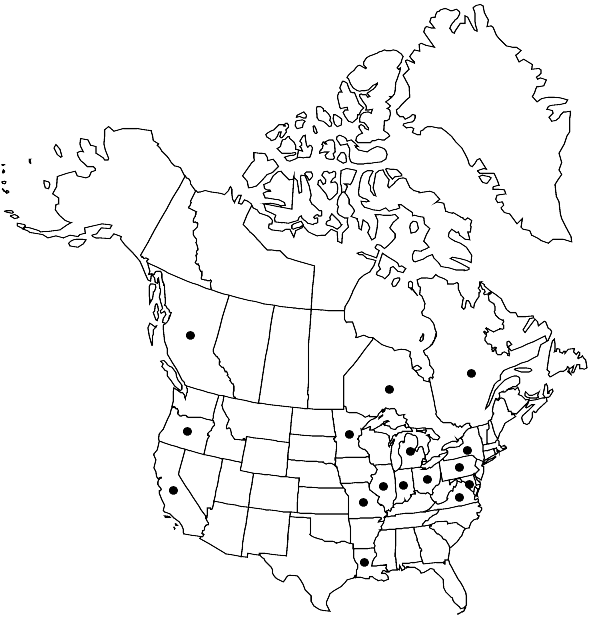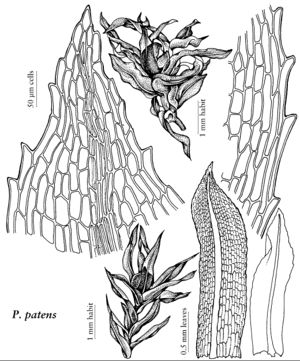Difference between revisions of "Physcomitrella patens"
Bryol. Europ. 1: 13. 1849,.
FNA>Volume Importer |
imported>Volume Importer |
||
| (6 intermediate revisions by 2 users not shown) | |||
| Line 6: | Line 6: | ||
|place=1: 13. 1849, | |place=1: 13. 1849, | ||
}} | }} | ||
| − | |basionyms={{Treatment/ID/ | + | |basionyms={{Treatment/ID/Basionym |
|name=Phascum patens | |name=Phascum patens | ||
|authority=Hedwig | |authority=Hedwig | ||
| + | |rank=species | ||
| + | |publication_title=Sp. Musc. Frond., | ||
| + | |publication_place=20. 1801 | ||
}} | }} | ||
|synonyms={{Treatment/ID/Synonym | |synonyms={{Treatment/ID/Synonym | ||
|name=Aphanorrhegma patens | |name=Aphanorrhegma patens | ||
|authority=(Hedwig) Lindberg | |authority=(Hedwig) Lindberg | ||
| + | |rank=species | ||
}} | }} | ||
|hierarchy=Funariaceae;Physcomitrella;Physcomitrella patens | |hierarchy=Funariaceae;Physcomitrella;Physcomitrella patens | ||
| Line 28: | Line 32: | ||
|elevation=low to moderate elevations | |elevation=low to moderate elevations | ||
|distribution=B.C.;Ont.;Que.;Calif.;Ill.;Ind.;La.;Md.;Mich.;Minn.;Mo.;N.Y.;Ohio;Oreg.;Pa.;Va.;c;n Europe;Asia (w Siberia). | |distribution=B.C.;Ont.;Que.;Calif.;Ill.;Ind.;La.;Md.;Mich.;Minn.;Mo.;N.Y.;Ohio;Oreg.;Pa.;Va.;c;n Europe;Asia (w Siberia). | ||
| − | |discussion=<p>Physcomitrella patens is fairly variable in leaf shape and stature. The species is similar to Aphanorrhegma, with which it is broadly sympatric, but far less common. It differs from A. serratum by the thin-walled exothecial cells and the unlobed calyptra.</p> | + | |discussion=<p><i>Physcomitrella patens</i> is fairly variable in leaf shape and stature. The species is similar to <i>Aphanorrhegma</i>, with which it is broadly sympatric, but far less common. It differs from <i>A. serratum</i> by the thin-walled exothecial cells and the unlobed calyptra.</p> |
|tables= | |tables= | ||
|references= | |references= | ||
| Line 37: | Line 41: | ||
-->{{#Taxon: | -->{{#Taxon: | ||
name=Physcomitrella patens | name=Physcomitrella patens | ||
| − | |||
|authority=(Hedwig) Bruch & Schimper | |authority=(Hedwig) Bruch & Schimper | ||
|rank=species | |rank=species | ||
| Line 52: | Line 55: | ||
|publication year= | |publication year= | ||
|special status= | |special status= | ||
| − | |source xml=https:// | + | |source xml=https://bitbucket.org/aafc-mbb/fna-data-curation/src/2e0870ddd59836b60bcf96646a41e87ea5a5943a/coarse_grained_fna_xml/V27/V27_264.xml |
|genus=Physcomitrella | |genus=Physcomitrella | ||
|species=Physcomitrella patens | |species=Physcomitrella patens | ||
Latest revision as of 21:25, 5 November 2020
Plants to 5 mm. Stems to 3.5 mm. Leaves to 2.5 × 1 mm, lanceolate or ovate-lanceolate to obovate, acuminate, not or weakly concave, margin of lanceolate leaves somewhat reflexed when dry, serrulate in distal 1/3, rarely below leaf median; costa ending near apex; proximal cells 65–135 × 15–45 µm, distal cells 36–66 × 12–27 µm; marginal cells sometimes longer that medial laminal cells, reaching 150 µm. Calyptra entire at base. Spores 21–33 µm.
Phenology: Capsules mature Aug–Jan.
Habitat: Early pioneer on wet mineral soil, river banks, fields
Elevation: low to moderate elevations
Distribution

B.C., Ont., Que., Calif., Ill., Ind., La., Md., Mich., Minn., Mo., N.Y., Ohio, Oreg., Pa., Va., c, n Europe, Asia (w Siberia).
Discussion
Physcomitrella patens is fairly variable in leaf shape and stature. The species is similar to Aphanorrhegma, with which it is broadly sympatric, but far less common. It differs from A. serratum by the thin-walled exothecial cells and the unlobed calyptra.
Selected References
None.
